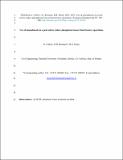| dc.contributor.author | Callery, Oisin | |
| dc.contributor.author | Brennan, Raymond B. | |
| dc.contributor.author | Healy, Mark G. | |
| dc.date.accessioned | 2017-07-12T07:48:25Z | |
| dc.date.issued | 2015-10-18 | |
| dc.identifier.citation | Callery, O., Brennan, R. B., & Healy, M. G. (2015). Use of amendments in a peat soil to reduce phosphorus losses from forestry operations. Ecological Engineering, 85, 193-200. doi: http://dx.doi.org/10.1016/j.ecoleng.2015.10.016 | en_IE |
| dc.identifier.issn | 1879-2448 | |
| dc.identifier.uri | http://hdl.handle.net/10379/6671 | |
| dc.description.abstract | Forestry harvesting on peats is known to result in significant losses of soil phosphorus (P) to adjacent waters, and the issue is becoming an increasingly serious concern as peatland forest stocks mature and reach harvestable age. One potential solution could be the use of low-cost P recovery techniques based on the chemical precipitation and/or adsorption of the dissolved fraction of soil P, which would otherwise be lost. Such recovery techniques have shown promise in similar applications on mineral soils. However, the interaction of peat with P adsorbing materials can significantly alter their adsorptive characteristics, and it is consequentially not known what materials might be suitable for this application. This study compared the performance of six potential soil amendments (aluminum water treatment residual (Al-WTR), crushed concrete, gypsum, magnesium hydroxide, magnesium oxide, and steel wool) in removing P from aqueous solution in the presence of a typical forest peat soil. Comparison of adsorption isotherms plotted from these batch adsorption studies showed that the observed P adsorption maxima of Al-WTR and steel wool were increased by the presence of peat, from 10.6 mg g-1 and 20.4 mg g-1, to 11.8 mg g-1 and 52.5 mg g-1, respectively. In contrast, the observed P adsorption maxima of crushed concrete, gypsum, and magnesium oxide were reduced in the presence of peat, by 44%, 87%, and 37%, respectively. The maximum P adsorption achieved by magnesium hydroxide was increased from 29.8 mg g-1 to 59 mg g-1 at an amendment to peat-solid ratio of 1:4, but decreased from 73.9 mg g-1 to 23.6 mg g-1 at an amendment to peat-solid ratio of 1:10. It was concluded that Al-WTR, in particular, shows considerable promise for use as a soil amendment for P immobilization in a peat environment. | en_IE |
| dc.description.sponsorship | The first author would like to acknowledge the Irish Research Council for funding. | en_IE |
| dc.format | application/pdf | en_IE |
| dc.language.iso | en | en_IE |
| dc.publisher | Elsevier | en_IE |
| dc.relation.ispartof | Ecological Engineering | en |
| dc.rights | Attribution-NonCommercial-NoDerivs 3.0 Ireland | |
| dc.rights.uri | https://creativecommons.org/licenses/by-nc-nd/3.0/ie/ | |
| dc.subject | Phosphorus | en_IE |
| dc.subject | Forestry | en_IE |
| dc.subject | Peat | en_IE |
| dc.subject | Clearfelling | en_IE |
| dc.subject | Harvesting | en_IE |
| dc.subject | Buffer zones | en_IE |
| dc.subject | Adsorption | en_IE |
| dc.title | Use of amendments in a peat soil to reduce phosphorus losses from forestry operations | en_IE |
| dc.type | Article | en_IE |
| dc.date.updated | 2017-07-11T14:21:27Z | |
| dc.identifier.doi | 10.1016/j.ecoleng.2015.10.016 | |
| dc.local.publishedsource | https://doi.org/10.1016/j.ecoleng.2015.10.016 | en_IE |
| dc.description.peer-reviewed | peer-reviewed | |
| dc.contributor.funder | |~|1267881|~|6201984|~| | |
| dc.description.embargo | 2017-10-18 | |
| dc.internal.rssid | 9913728 | |
| dc.local.contact | Mark Healy, Room Eng-1038, Civil Engineering, Col Of Engineering & Informatics, Nui Galway. 5364 Email: mark.healy@nuigalway.ie | |
| dc.local.copyrightchecked | No | |
| dc.local.version | PUBLISHED | |
| nui.item.downloads | 536 | |


